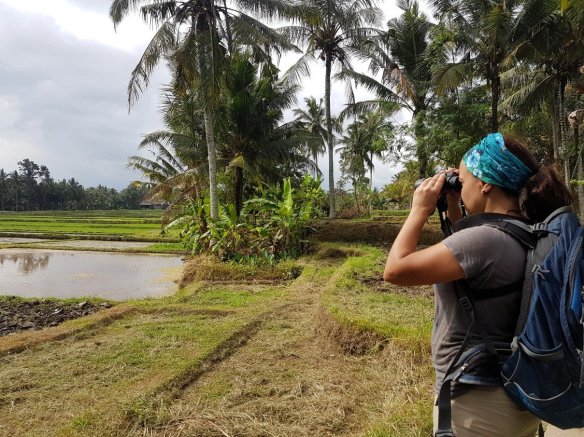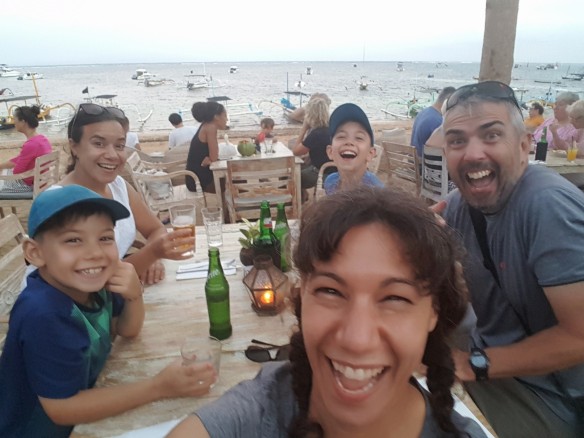It had come, at last: the last 10 days of our trip. Our final hurrah to Asia, to being free, to adventure. While our hearts were heavy, we were also starting to move on, mentally – we had registered for soccer back home, spoken with our renter about move-out timing, and made Easter plans with the family back in Canada. It’s hard to be grounded and present when you’re faced with reality, but we tried to ensure we soaked in as much as possible while we could.
We arrived by night train at 5 am into Hanoi, after a restless but exciting night rolling over 500 km through the Vietnamese countryside from the centre to the capital city in the north. After a streetside coffee in the dark with other early morning risers, we grabbed a taxi to our hotel. In between naps we spent a day of gentle explorations of the west end of Ho Tay lake; a residential neighbourhood with coffee shops, schools, butchers and barbers, and the ubiquitous flower vendors on their bikes.

Arriving in Ha Noi

School drop-off Chaos

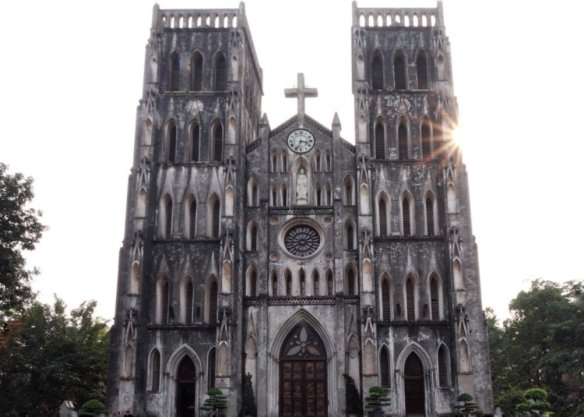
The next morning we ventured to Tam Dao, a hilltop station 80 km to the north. The steep switchbacks were starting to get us car sick by the time we arrived at the village on the mountaintop, nestled in the fog. It’s a very small town, with hotels piled haphazardly on top of one another, some old and empty, with odd castle-like monstrosities in a state of half-build.

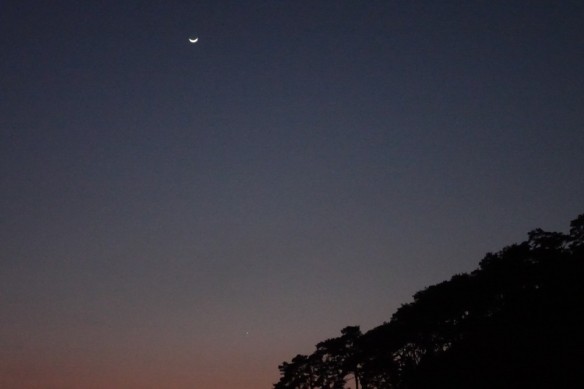

There’s a small market on the main street, where they sell the specialities of the area: piles of freshly harvested su su, a tasty green leafy vegetable, and tables of poached meat from the surrounding forests, including porcupines and squirrels. It was hard to visit restaurants for the 3 nights we were here, as menus included a shocking array of wildlife: deer, turtle, pheasants, trogons, you name it. Needless to say, we ate vegetarian noodle dishes for dinner, and the safe (and delicious) bun cha from a local street vendor for lunch. Breakfast was a steaming bowl of Pho, which was a mental roadblock, but delicious and filling. While we saw and heard some formidable karaoke in town, we decided not to join in *ahem*. Walking the short circle road around the main square allowed us to be entertained by the antics of the numerous wedding and engagement photo shoots, various cock fights, as well as be included in selfies with Vietnamese tourists.
[Clockwise from Left: Local vendors selling their produce, cocks ready for their next fight, Pho for breakfast, the town square where we were asked for selfies, a bowl of Bun Cha, porcupine and squirrel meat, Com Lam: coconut and sticky rice stuffed bamboo]
This stop was very much centered on a final big birding push. There were some good birds to be seen here, and we were ready to go hard for a few days. Scouting our route on the first afternoon, we walked over to the government-manned gate at the start of the road winding through the national park. We were surprised by a sign blocking access, and confronted by unfriendly guards who presented us with a firm NO, for reasons unbeknownst to us. We returned with our friendly english-speaking hotel manager, hoping that with a translation and explanation of our case, we could convince the guards to let us pass. Alas, we had no luck, and were turned away. We were more then disappointed; we were angry. But arguing with a government official isn’t always the best path to take, so we pulled ourselves up by our bootstraps and came up with a plan B – hiking the 1000 steps up to the radio tower on an adjacent hill. The habitat wasn’t as pristine, and the path was busier than we would have liked, but considering our options, at least we managed to do a bit of birding. We did see some incredible species – Short-tailed Parrotbill, Black-chinned Yuhinia, David’s Fulvetta, Red-billed Blue Magpie, and a few endangered Laughingthrushes (which I won’t name, to protect them from further persecution). We even encountered a couple of bird tour groups who mentioned how they had to bribe the guards to get into the park, and who were flitting in and out of town, missing out on the eccentric personality of this little mountain village. There are many ways to travel, and our way might not get us all that we want, but we definitely manage to see a slice of culture that is authentic, and we are grateful for that.

Where we hoped to bird, but weren’t allowed in

Where we ended up birding, with some success
Once more, considering how difficult the circumstances were in Tam Dao, the kids were troopers – patient while we pursued sounds in the underbrush, and open to changes in plans, as well as new foods and experiences. We are so proud of them, and we’d happily jump into more adventures with them, anyday.
After Tam Dao, we went back to Hanoi to get ready for the next few days of travel. We decided to switch things up a bit, and treat ourselves with a tour into Bai Tu Long Bay on a Junk boat! We booked through Indochina Junk, and chose a smaller boat with only 20 passengers, for 3 days and 2 nights. We had seen pictures of Ha Long Bay, and while it looked beautiful, we weren’t impressed by the unsustainable numbers of daily tourists. Our tour meant quieter bays with less boats, with (hopefully) less of an environmental impact. It was more luxurious than anything we had done over the last 9 months, but it was a welcome relief to not do any planning for the next few days, with excellent food and service, and lovely views and fun activities. There were wonderful guests to chat with, and friendly and helpful staff. The tour included a water puppet show, a cooking class, a visit to a floating village and a pearl factory, a cave visit, some squid fishing, and a couple of kayaking excursions through the bay, one of which ended with a large and sumptuous seafood lunch on a private beach. We had wonderful weather, and the location was spectacular – hundreds of karst mountains jutting out of calm green waters; if it all sounds magical, that’s because it truly was.





After our tour, we landed in Hanoi with only three nights left on our trip. We filled them the best way possible: by wandering the streets of this vibrant city. We ate fabulous bun cha and drank mango smoothies, bought beautiful local handmade pottery and fabric, visited the incredible Women’s Museum, had heartfelt interactions with locals, crossed the streets and didn’t die, watched men play board games and women giggle while chopping pineapples.
It wasn’t all sunshine and roses: at this point we were tired of noodles and rice, our lungs were feeling the effects of the ever-present smog, and our nights were being interrupted by honking horns and barking dogs. Speaking of dogs, this was the first time we actually saw cooked dog meat for sale on the street; it’s a sight that was sad and sobering, and will be hard to forget. We were also saddened by all the caged songbirds hanging in storefronts, but were grateful for the ones we had seen in the wild.

Vietnam is a huge country that is economically strong, with a powerful past and an exciting future. We have walked UNESCO villages, seen natural caves that were jaw-dropping, witnessed traditional fishing and rice farming, hiked through jungles and sailed through bays. After a month in this great land, we fell in love with it all, and want to see so much more – the Sapa terraces, the birds in Dalat, the coast at Nha Trang, the old city of Hue, the bioluminescence in Ha Long Bay…the list goes on and on. Our desire to see the world is not at all appeased by travel – in fact, with every step on foreign soil, with every sampled strange food, with every new bird, with every wonderful connection with another culture, our wanderlust grows. It’s a beautiful world; we can’t wait to see more of it.
Theresa
















































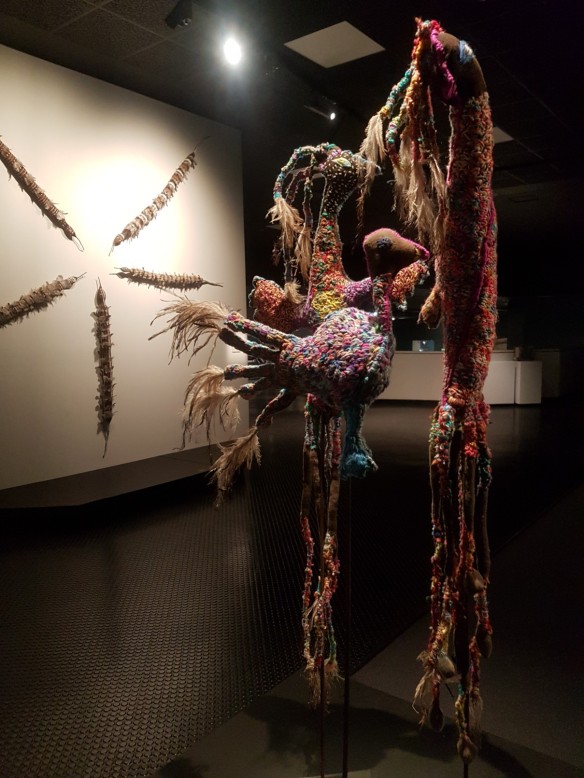












 We spent time in Ubud, the cultural center of Bali, to visit temples and the palace, and to take in a dance and music performance. The costumes, darting eyes, and intricate finger movements left quite an impression on the kids. A visit to Monkey Forest in Ubud was…interesting. It was worse than we expected, a tourist trap where monkeys were exploited for photos. Let’s just say it wasn’t worth the visit.
We spent time in Ubud, the cultural center of Bali, to visit temples and the palace, and to take in a dance and music performance. The costumes, darting eyes, and intricate finger movements left quite an impression on the kids. A visit to Monkey Forest in Ubud was…interesting. It was worse than we expected, a tourist trap where monkeys were exploited for photos. Let’s just say it wasn’t worth the visit.

